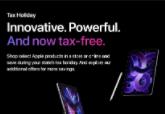This is the world's most profitable market for smartphones, and the most closed
The duo has dominated the US market for a decade, with Statcounter data showing that Apple's iPhone US market share broke the 50% mark for the first time in 2012 and has never fallen below the 50% threshold since then. Samsung's market share has also remained above 25% since 2014, reaching a high of 34% at one point.
The exit of two major players from the US smartphone market over the past decade has also left Apple and Samsung without a competitor.
HTC was second in the US smartphone market in 2011 with a 21% market share, behind the iPhone, but the Android pioneer fell rapidly over the next few years, falling below 1% of the US market in 2017 and eventually disappearing from the market altogether.
In April last year, LG officially announced its exit from the smartphone market, abandoning its mobile phone business after 26 years. The phone maker, which once held the third largest share of the global market, had long held a 7 per cent market share in the US, relying on carrier channels to ship low-end and mid-range phones. Even in 2022, LG will continue to sell some low-end handsets in the open market, but the carrier channel is nowhere to be found.
Still relying on carriers for shipments
The US smartphone market is still an overwhelmingly carrier-dominated market, even if the rest of the world has already made the transition. In such a market, even products that are not competitive in other countries can be shipped in significant numbers if they enter the US carrier channel.
What other phones can be bought in the US market now? In the networks of the four major carriers, apart from Apple and Samsung, there are only Motorola, Google Pixel and OnePlus, with the occasional Kyocera, TCL and Nokia. In the open market, there are also brands such as ZTE and Sony to choose from.
As a direct result of this lack of competition, Apple and Samsung phones have the lion's share of shipments in the carrier channel. a survey by market research firm Wave7 Reserch in early 2020 estimated that 90 per cent of phones sold by US carriers in December 2019 were Apple and Samsung. These two phone brands even accounted for 95% of sales at AT&T.
US consumers are habitually dependent on their carriers, and until 2015, Americans were used to taking home an iPhone on contract for just $199. Of course, they were also paying more than $75 a month for a contract (on a 2GB traffic package). But after the carriers removed their subsidies, Americans still used to buy their phones from the carriers and then get on the network. (There are still carriers that offer subsidies ranging from $100-$200 for on-net purchases.)
Access to the carrier channel directly determines how much a phone will be shipped. The most direct example of this is the fact that LG has been able to maintain steady shipments in the US, even ranking third in the market, despite losing ground around the world over the past few years; in the third quarter of 2020, the North American market accounted for 64% of LG's smartphone shipments. The lack of competition in the US market is also evident from this perspective.
Prior to 2017, ZTE had also relied on carrier channels and shipped a large number of low-end phones. At its peak in 2016, ZTE was at one point selling 70 phones simultaneously on four major carriers, shipping over 16 million units a year and ranking fourth in the US market for shipments behind Apple, Samsung and LG. but this was all entirely dependent on the carriers, and for reasons that are well known, ZTE then said goodbye to the US carrier platform and also quickly disappeared from the US market.
LG withdraws from Moto to take over
Runar Bjørhovde, an analyst at market research firm Canalys, wrote in his report that after LG announced its exit from the smartphone business, Lenovo-owned Motorola became the biggest beneficiary, filling LG's previously low-end and mid-range handset business and moving into the top three in the US market. He writes that Moto has found new market opportunities through the carrier channel, with a particular focus on prepaid and mid-range phones.
First quarter statistics from Canalys show that Motorola has finally broken into double digits in the US smartphone market share. And years after its launch, Google's own brand, the Pixel, has finally gained a 3% market share in the US, with 1.2 million units shipped in the quarter.
OTHER NEWS
-
- Apple AirPods Pro 2 wireless headphones open full feature threshold revealed: pairing compatible with iPhone 11 and newer phones, some iPads and M1 / M2 Macs
- By 22 Jul,2022

-
- Apple's iPhone 14 / Pro Series satellite communication feature will be extended to more countries / regions, sources say
- By 19 Sep,2022

-
- Apple's Limited-Time Sales Tax-Free Shopping Coming to 9 U.S. States: Covering Mac, iPad, iPhone and More
- By 26 Jul,2022

-
- The first jailbreak tool for Apple iOS 15 is coming soon
- By 20 Jul,2022

-
- Apple Apple Arcade's first batch of games taken offline as contract with developer ends
- By 5 Aug,2022

-
- Apple: Apple Watch Ultra and AirPods Pro 2 available in retail stores starting Friday, September 23
- By 26 Sep,2022
